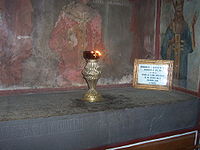
Bistrita Monastery
Encyclopedia


Romanian Orthodox Church
The Romanian Orthodox Church is an autocephalous Eastern Orthodox church. It is in full communion with other Eastern Orthodox churches, and is ranked seventh in order of precedence. The Primate of the church has the title of Patriarch...
monastery
Monastery
Monastery denotes the building, or complex of buildings, that houses a room reserved for prayer as well as the domestic quarters and workplace of monastics, whether monks or nuns, and whether living in community or alone .Monasteries may vary greatly in size – a small dwelling accommodating only...
located 8 km west of Piatra Neamţ
Piatra Neamt
Piatra Neamț , , ; is the capital city of Neamţ County, in the historical region of Moldavia, eastern Romania. Because of its privileged location in the Eastern Carpathian mountains, it is considered one of the most picturesque cities in Romania...
. It was dedicated in 1402 by Romanian Voivode Alexandru cel Bun
Alexandru cel Bun
Alexander cel Bun was a Voivode of Moldavia, reigning between 1400 and 1432, son of Roman I Mușat. He succeeded Iuga to the throne, and, as a ruler, initiated a series of reforms while consolidating the status of the Moldavian Principality....
whose remains are buried here.
The monastery is surrounded by 4 meter high stone walls built during Petru Rareş
Petru Rares
Peter IV Rareș was twice voievod of Moldavia: 20 January 1527 to 18 September 1538 and 19 February 1541 to 3 September 1546. He was an illegitimate child born to Ștefan cel Mare...
's reign (1541-1546), the original ones being destroyed in 1538 by Suleiman the Magnificent
Suleiman the Magnificent
Suleiman I was the tenth and longest-reigning Sultan of the Ottoman Empire, from 1520 to his death in 1566. He is known in the West as Suleiman the Magnificent and in the East, as "The Lawgiver" , for his complete reconstruction of the Ottoman legal system...
's army. Also from the same period dates a chapel located north of the monastery.
The church is historically and archaeologically valuable. It shows features of Byzantine architecture, has many beautiful ornaments, the 15th century entrance door being a work of fine craftsmanship.
The bell tower was erected in 1498 by Stephen the Great
Stephen III of Moldavia
Stephen III of Moldavia was Prince of Moldavia between 1457 and 1504 and the most prominent representative of the House of Mușat.During his reign, he strengthened Moldavia and maintained its independence against the ambitions of Hungary, Poland, and the...
.
A remarkable item preserved here is the miraculous icon of Saint Anne
Saint Anne
Saint Hanna of David's house and line, was the mother of the Virgin Mary and grandmother of Jesus Christ according to Christian and Islamic tradition. English Anne is derived from Greek rendering of her Hebrew name Hannah...
given as a present to the monastery by Manuel II Palaiologos
Manuel II Palaiologos
Manuel II Palaiologos or Palaeologus was Byzantine Emperor from 1391 to 1425.-Life:...
, emperor of Constantinople
Constantinople
Constantinople was the capital of the Roman, Eastern Roman, Byzantine, Latin, and Ottoman Empires. Throughout most of the Middle Ages, Constantinople was Europe's largest and wealthiest city.-Names:...
.
The monastery was an important cultural center for calligraphers
Calligraphy
Calligraphy is a type of visual art. It is often called the art of fancy lettering . A contemporary definition of calligraphic practice is "the art of giving form to signs in an expressive, harmonious and skillful manner"...
, miniaturists and chroniclers. The monastery's museum hosts an important collection of medieval art.

